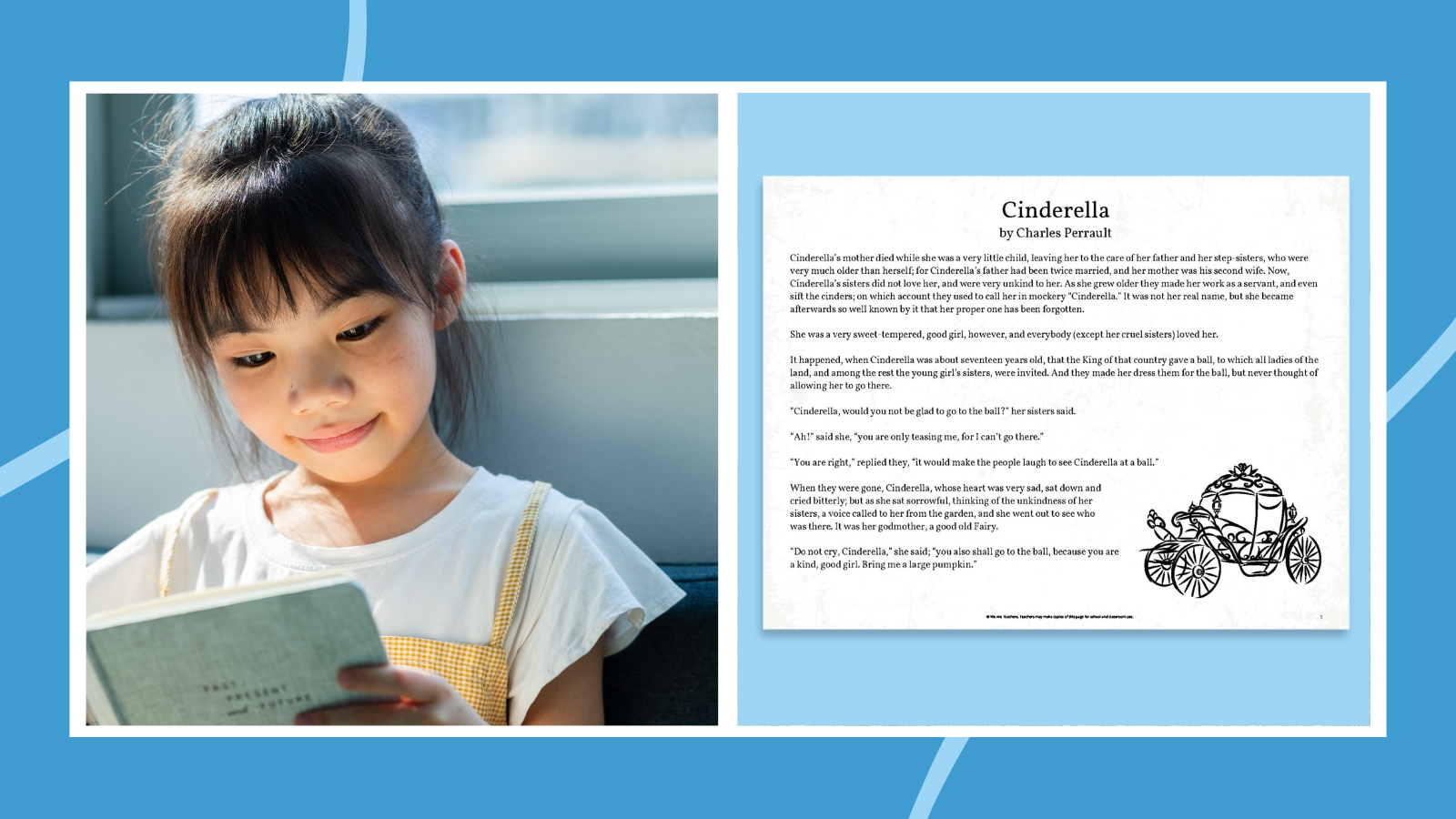Looking for some free tales to use for close reading or classroom read-alouds? This roundup of short stories for kids has plenty of options. From quick fables with morals to old-fashioned fairy tales and folktales from around the world, this diverse collection offers something for any child. We’ve also included ways to use these short stories with kids, in the classroom or at home. You can get free printable copies of the short stories by simply filling out the form on this page.
Note: Always be sure to read a selection through before sharing it with children. Some of these short stories for kids, especially ones written a long time ago, may not be appropriate for every audience.
Classic Fairy Tale Short Stories for Kids
“Cinderella” by Charles Perrault
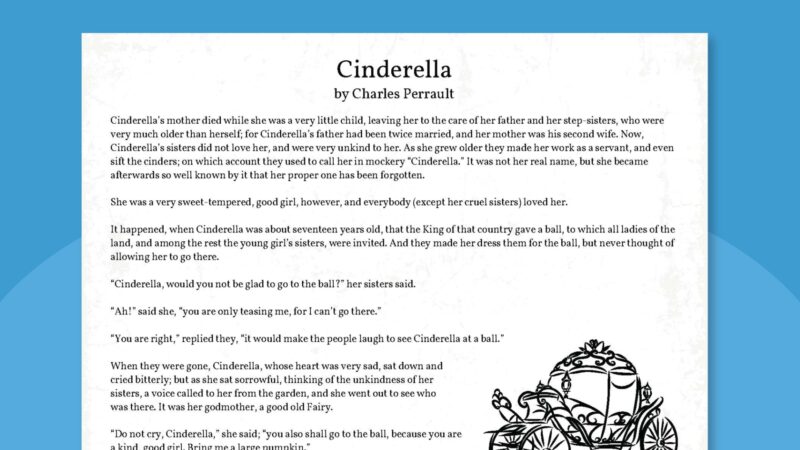
“‘Do not cry, Cinderella,’ she said; ‘you also shall go to the ball, because you are a kind, good girl.’”
Why we love it: This is one of those short stories for kids that everyone probably already knows. This older version is a little different than the Disney movie, so ask kids if they can identify the changes. They can also have fun imagining what other items could be transformed to help Cinderella get to the ball!
“Thumbelina” by Hans Christian Andersen
“There once was a woman who wanted so very much to have a tiny little child, but she did not know where to find one. So she went to an old witch, and she said: ‘I have set my heart upon having a tiny little child. Please could you tell me where I can find one?’”
Why we love it: If there’s one thing this world can use more of, it is definitely kindness. We love that the story of Thumbelina spreads the message that kindness pays off in big ways. Thumbelina helps the swallow and in turn finds her true love.
“The Emperor’s New Clothes” by Hans Christian Andersen
“‘But the Emperor has nothing at all on!’ said a little child.”
Why we love it: This is a wonderful story for talking about peer pressure and being brave enough to stand up for what you believe in. Kids will also enjoy drawing the imaginary suit of clothes that the king thought he saw.
“The Little Mermaid” by Hans Christian Andersen
“‘It was you,’ said the prince, ‘who saved my life when I lay dead on the beach,’ and he folded his blushing bride in his arms. ‘Oh, I am too happy,’ said he to the little mermaid; ‘my fondest hopes are all fulfilled. You will rejoice at my happiness; for your devotion to me is great and sincere.’”
Why we love it: The story of the Little Mermaid focuses on sacrificial love. In it, the Sea King puts the needs of his daughter over his own. Open a dialogue with kids about a time when they put someone else’s needs over their own.
“Rapunzel” by The Brothers Grimm
“There once lived a man and his wife, who had long wished for a child, but in vain. Now there was at the back of their house a little window which overlooked a beautiful garden full of the finest vegetables and flowers; but there was a high wall all round it, and no one ventured into it, for it belonged to a witch of great might, and of whom all the world was afraid.”
Why we love it: This story explores themes of autonomy, love, jealousy, and freedom. Children need to be set free to explore their own lives.
“The Frog Prince” by The Brothers Grimm
“And the princess, though very unwilling, took him up in her hand, and put him upon the pillow of her own bed, where he slept all night long. As soon as it was light, he jumped up, hopped downstairs, and went out of the house. ‘Now, then,’ thought the princess, ‘at last he is gone, and I shall be troubled with him no more.’”
Why we love it: Kids love this familiar story about a prince in disguise and a young girl who keeps her word even though she doesn’t want to. In this version, the girl doesn’t need to kiss the frog, but she’s rewarded anyway.
“The Gingerbread Man” by Anonymous
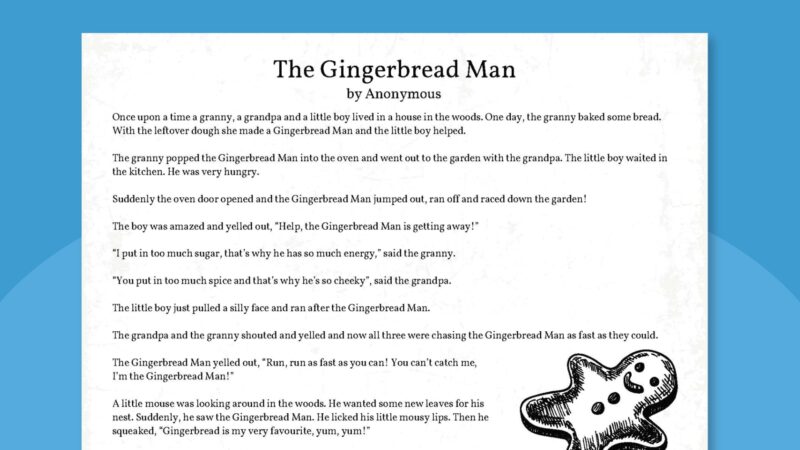
“‘Run, run as fast as you can! You can’t catch me, I’m the Gingerbread Man!’”
Why we love it: In the original tale, the Gingerbread Man is eventually caught and eaten. This retelling gives him a happy ending instead. For a fun activity, let kids decorate and eat their own gingerbread people.
“The Velveteen Rabbit” by Margery Williams
“‘Real isn’t how you are made,’ said the Skin Horse. ‘It’s a thing that happens to you. When a child loves you for a long, long time, not just to play with, but REALLY loves you, then you become Real.’”
Why we love it: This is one of the most classic short stories for kids of all time! Let kids bring their own favorite toys to share with the class, and have them write or tell stories about what would happen if they became “real.”
“The Elves and the Shoemaker” by The Brothers Grimm
“A shoemaker, by no fault of his own, had become so poor that at last he had nothing left but leather for one pair of shoes. So in the evening, he cut out the shoes which he wished to begin to make the next morning, and as he had a good conscience, he lay down quietly in his bed, commended himself to God, and fell asleep.”
Why we love it: Short stories for kids that are packed with life lessons are tops in our book. Among the lessons found in this tale are to work hard and to be grateful for the help you receive. It was through his hard work that the shoemaker achieved riches and success.
“The Wolf and the Seven Young Goats” by The Brothers Grimm
“There was once an old goat who had seven little ones, and was as fond of them as ever a mother was of her children.”
Why we love it: Some of the best short stories for kids serve as cautionary tales. In this story, the young goats fail to heed their mother’s warning and succumb to the wolf’s attempts at deceit.
“The Snow Queen” by Hans Christian Andersen
“Now then, let us begin. When we are at the end of the story, we shall know more than we know now: but to begin.”
Why we love it: This story is the classic struggle between good and evil. It also focuses on the values of friendship and perseverance.
“Jack and the Beanstalk” by Anonymous
“Why, the beans his mother had thrown out of the window into the garden had sprung up into a giant beanstalk which went up and up and up until it reached the sky. So the man spoke truth after all!”
Why we love it: This story is a fun read, but use it to get your students thinking critically. Was it really OK for Jack to steal from the giant? Ask them to write an essay sharing their thoughts on the subject, or use it for a fun classroom debate.
“Little Red Riding Hood” by The Brothers Grimm
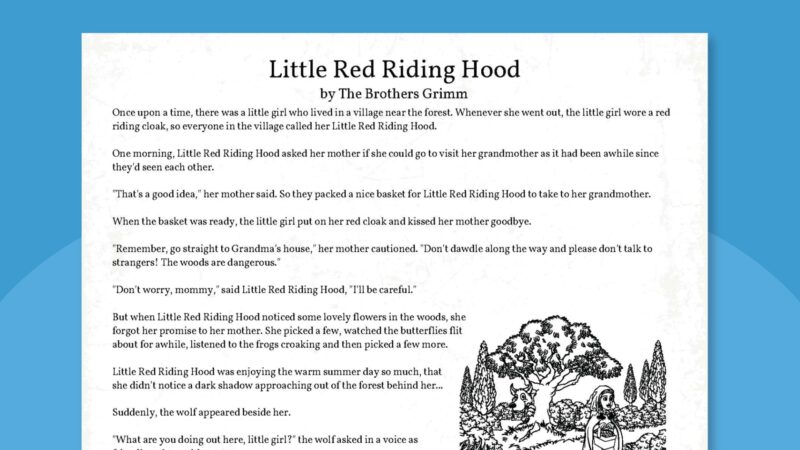
“‘But Grandmother! What big eyes you have,’ said Little Red Riding Hood.
‘The better to see you with, my dear,’ replied the wolf.”
Why we love it: This retelling of the well-known tale is a little less gruesome, since the hunter merely frightens the wolf into spitting out poor granny (instead of slicing open his belly). Talk with kids about ways they can keep themselves safe when they’re out in the world.
“The Pied Piper of Hamelin” by The Brothers Grimm
“He sounded his fife in the streets, but this time it wasn’t rats and mice that came to him, but rather children: a great number of boys and girls from their fourth year on. Among them was the mayor’s grown daughter. The swarm followed him, and he led them into a mountain, where he disappeared with them.”
Why we love it: Some say this is a true story, and whether or not it’s true, it definitely has a moral—when people make a bargain, they should stick to their agreement. Ask kids to think about what kind of music the Pied Piper might have played, and why both children and rats couldn’t resist it.
“The Princess and the Pea” by Hans Christian Andersen
“I cannot think what could have been in the bed. I lay upon something so hard that I am quite black and blue all over.”
Why we love it: This has long been one of the most beloved short stories for kids, and it’s ideal when you need a quick read. Then, grab some dried peas and see how thick a covering needs to be before students can no longer feel them.
“Puss in Boots” by Charles Perrault
“Puss became a great lord, and never ran after mice anymore, except for pleasure.”
Why we love it: All cat lovers know these animals can be pretty smart when they want to be. This one helps his poor master become a prince in a castle, all through his own clever tricks. Encourage students to come up with more creative ways Puss in Boots could help his master.
“Rumpelstiltskin” by The Brothers Grimm
“‘I will give you three days,’ said he, ‘if by that time you find out my name, then shall you keep your child.’”
Why we love it: Pretty much everyone in this story behaves badly in one way or another. Use it to learn more about characters and their motivation.
“Sleeping Beauty” by The Brothers Grimm
“A great many changes take place in a hundred years.”
Why we love it: After students read this well-known story, ask them to think about what it would be like to go to sleep today and wake up in a hundred years. What might the world be like? Or what would it be like for someone who fell asleep a hundred years ago to wake up today? How many things have changed since then?
“Snow White and the Seven Dwarfs” by The Brothers Grimm
“‘Mirror, mirror on the wall, who’s the fairest of them all?’”
Why we love it: This fairy tale has all the classic elements—beautiful heroine, wicked stepmother, handsome prince—plus a handful of helpful dwarfs. It’s the perfect way to start a conversation about the dangers of envy and jealousy.
“The Three Little Pigs” by Anonymous
“‘Not by the hairs on our chinny chin chin!’”
Why we love it: Fairy tales don’t get much more classic than this. Follow it up with a reading of The True Story of the Three Little Pigs by Jon Scieszka to hear the story from the wolf’s perspective, and have a conversation about point of view.
“The Ugly Duckling” by Hans Christian Andersen
“But what did he see there, mirrored in the clear stream? He beheld his own image, and it was no longer the reflection of a clumsy, dirty, gray bird, ugly and offensive. He himself was a swan! Being born in a duck yard does not matter, if only you are hatched from a swan’s egg.”
Why we love it: Whether you read the original text or a shorter adaptation, this story is one every kid should know. It will teach them that everyone should be proud of who they are, even if they don’t look or feel like everyone else.
Aesop’s Fables as Short Stories for Kids
“The Ants and the Grasshopper” by Aesop
“One bright day in late autumn a family of Ants were bustling about in the warm sunshine, drying out the grain they had stored up during the summer, when a starving Grasshopper, his fiddle under his arm, came up and humbly begged for a bite to eat.”
Why we love it: It can be hard to teach kids that there are things in life they need to do regardless of whether they are fun or not. This fable will help little ones understand the value of putting in hard work to set ourselves up for future successes.
“The Boy Who Cried Wolf” by Aesop
“So now, though he had not seen anything that even looked like a Wolf, he ran toward the village shouting at the top of his voice, ‘Wolf! Wolf!’”
Why we love it: This might be the most famous short story we use to teach kids about how important it is to tell the truth. Ask students if they’ve ever pulled a prank that went wrong and what they learned from it.
“The Crow and the Pitcher” by Aesop
“But the pitcher was high and had a narrow neck, and no matter how he tried, the Crow could not reach the water.”
Why we love it: Aesop’s fable reads more like a STEM challenge—how can you reach the water at the bottom of the pitcher when your neck isn’t long enough? Try the same experiment with your students, using a narrow-necked bottle. Can they come up with any other solutions?
“The Fox and the Grapes” by Aesop
“The grapes seemed ready to burst with juice, and the Fox’s mouth watered as he gazed longingly at them.”
Why we love it: If kids have ever wondered where the phrase “sour grapes” comes from, this tale will answer that question. Talk about other idiomatic phrases, and do some research to find their origins.
“The Lion and the Mouse” by Aesop
“‘You laughed when I said I would repay you,’ said the Mouse. ‘Now you see that even a Mouse can help a Lion.’”
Why we love it: This fable reminds kids that they’re never too small to make a difference in someone’s life. Ask kids to share their own stories of times they helped someone.
“The Tortoise and the Hare” by Aesop
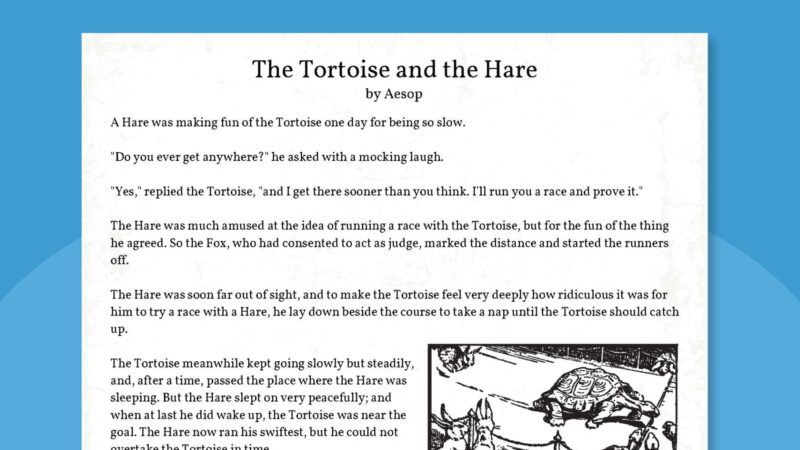
“The Hare was soon far out of sight, and to make the Tortoise feel very deeply how ridiculous it was for him to try a race with a Hare, he lay down beside the course to take a nap until the Tortoise should catch up.”
Why we love it: When kids need a reminder that they should always keep trying, turn to this famous story. Use it to teach growth mindset too.
“Two Travelers and a Bear” by Aesop
“Two men were traveling in company through a forest, when, all at once, a huge bear crashed out of the brush near them.”
Why we love it: When danger strikes, do you worry about yourself first or try to help everyone to safety? There are arguments to be made on both sides, so this one makes for an interesting debate or persuasive essay.
More Short Stories for Kids
“Anansi and the Pot of Wisdom” by Anonymous
“Every time Anansi looked in the clay pot, he learned something new.”
Why we love it: Kids may know about Anansi from the popular book Anansi the Spider, but there are lots of tales about him in West African folklore. In this one, Anansi thinks he knows everything, but a child has something new to teach him. Explore more Anansi tales here.
“The Apple Dumpling” by Anonymous
“A bag of feathers for a basket of plums. A bunch of flowers for a bag of feathers. A golden chain for a bunch of flowers. And a dog for a golden chain. All the world is give and take, and who knows if I may have my apple dumpling yet.”
Why we love it: When an old woman sets out to trade her basket of plums for some apples, her quest takes a few twists and turns along the way. In the end, though, she manages to make many people happy, not just herself. Practice sequencing by having kids try to remember all the trades the woman makes and the order she makes them in.
“The Blind Men and the Elephant” retold by James Baldwin
“This elephant is not like a wall, or a spear, or a snake, or a tree; neither is he like a fan. But any man with a par-ti-cle of sense can see that he is exactly like a rope.”
Why we love it: Six blind men each feel a different part of an elephant, and each comes to his own very different conclusions. Written as a very short play, this classic tale opens up all sorts of discussion opportunities about seeing the bigger picture.
“Bruce and the Spider” by James Baldwin
“But the spider did not lose hope with the sixth failure. With still more care, she made ready to try for the seventh time. Bruce almost forgot his own troubles as he watched her swing herself out upon the slender line. Would she fail again? No! The thread was carried safely to the beam, and fastened there.”
Why we love it: This famous little tale is almost certainly a myth, but it’s one of the most well-known stories about King Robert the Bruce. The lesson about not giving up fits perfectly when you’re talking about growth mindset.
“The Elephant’s Child” by Rudyard Kipling
“But there was one Elephant—a new Elephant—an Elephant’s Child—who was full of ‘satiable curtiosity,’ and that means he asked ever so many questions.”
Why we love it: Many kids will recognize themselves in the Elephant’s Child and his (in)satiable curiosity. After you read this one, have students come up with stories for the way other animals got their unique features. How did the giraffe get its long neck? How did the turtle get its shell? So many possibilities!
“Paul Bunyan” by William B. Laughead

“When Paul was a boy, he was fast as lightning. He could blow out a candle at night and hop into bed before it was dark.”
Why we love it: Paul Bunyan is an American folk hero, larger than life (literally!). This roundup of the legends surrounding him has many of the most famous tales. Encourage kids to think about what they’d do if they were as big, strong, and fast as Paul.
“The Little Engine That Could” retold by Watty Piper
“I think I can. I think I can.”
Why we love it: When little ones learn early on to believe in themselves, they’ll be willing to try their best at anything. Have kids tell their own stories of times they did something that seemed impossible at first when they kept on trying.
“The Four Dragons” by Anonymous
“The four dragons flew back and forth, making the sky dark all around. Before long the sea water became rain pouring down from the sky.”
Why we love it: The four dragons in this Chinese tale want to help save the people from drought. When the Jade Emperor won’t help, they take matters into their own hands. Ultimately, they become the four major rivers of China. This is a great opportunity to get out the globe or pull up Google Earth and learn more about China’s geography.
“Henny Penny” by Anonymous
“So Henny-Penny, Cocky-Locky, Ducky-Daddles, Goosey-Poosey and Turkey-Lurkey all went to tell the king the sky was a-falling.”
Why we love it: In an age when people are quick to spread rumors as fact, this old European folktale is more meaningful than ever. See if kids can think of times when they heard a crazy rumor that they believed at first, even though it turned out to be completely false.
“How Gimme the Ax Found Out About the Zigzag Railroad” by Carl Sandburg
“Then the zizzies came. The zizzy is a bug. He runs zigzag on zigzag legs, eats zigzag with zigzag teeth, and spits zigzag with a zigzag tongue.”
Why we love it: Kids will get a kick out of all the Z sounds in this silly little story about why some local railroad tracks run in zigzags. Use it to teach about alliteration and consonance, and ask kids to draw their own pictures of the zizzies.
“King Midas and the Golden Touch” by Anonymous
“Suddenly, he started to sense fear. Tears filled his eyes and that moment, his beloved daughter entered the room. When Midas hugged her, she turned into a golden statue!”
Why we love it: Teach kids to be careful what they wish for. Ask them to make a list of wishes, then talk about ways each of them could ultimately go wrong. Have them write their own version of this short story.
“The Kite That Went to the Moon” by Evelyn Sharp
“‘I have everything in the world in my bag,’ replied the little old man, ‘for everything is there that everybody wants. I have laughter and tears and happiness and sadness; I can give you riches or poverty, sense or nonsense; here is a way to discover the things that you don’t know, and a way to forget the things that you do know.’”
Why we love this: This whimsical tale takes two small children on a voyage to the moon and back, as they follow an enchanted kite. Pair it with a crafting session where kids make their own kites to fly.
“The Monkey and the Turtle” by José Rizal
“A monkey and a turtle found a banana tree on a river. They fished it out and because each wanted the tree for himself, they cut it in half.”
Why we love it: A monkey and a turtle each plant half a banana tree, but only the turtle’s grows. The monkey offers to harvest the fruit but keeps it all for himself. But the turtle has plans of his own! This folktale from the Philippines is actually an allegory about the Spanish colonizers’ treatment of the Filipino people.
“The Tale of Peter Rabbit” by Beatrix Potter
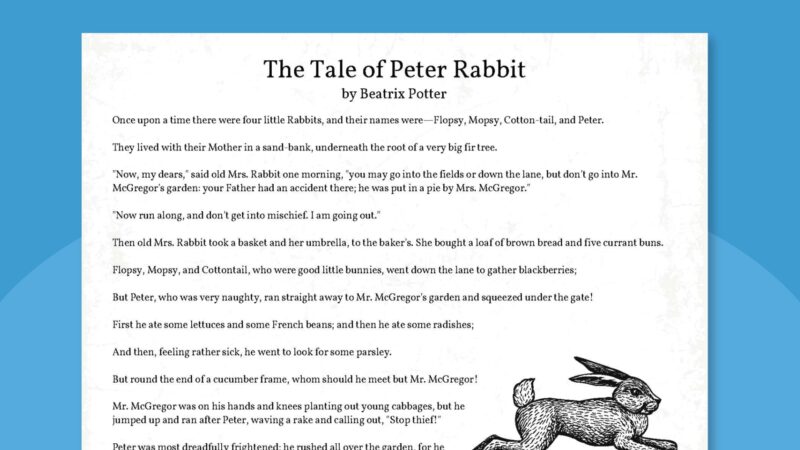
“‘NOW, my dears,’ said old Mrs. Rabbit one morning, ‘you may go into the fields or down the lane, but don’t go into Mr. McGregor’s garden: your Father had an accident there; he was put in a pie by Mrs. McGregor.’”
Why we love it: Beatrix Potter’s sweet tales are beloved, but this is the one that has really endured. Pair it with one of these terrific Peter Rabbit activities.
“Rikki-Tikki-Tavi” by Rudyard Kipling
“Rikki-tikki did not care to follow them, for he did not feel sure that he could manage two snakes at once. So he trotted off to the gravel path near the house, and sat down to think. It was a serious matter for him.”
Why we love it: Reading this story is like watching a nature documentary unfold on the page. Have kids do some research on the mongoose and its relationship with cobras in real life.
“The Story of the Chinese Zodiac” by Anonymous
“He reached out his paws and pushed his friend the cat into the river. The cat was swept away by the whirling waters. That is why there is no cat in the Chinese calendar.”
Why we love it: This short little tale manages to answer two questions: why there’s no Year of the Cat and why cats and rats can’t be friends. After reading it, try to imagine how the other animals in the calendar managed to win their spots.
“Weighing the Elephant” by Anonymous
“‘Very well,’ said the Emperor, humoring the boy. ‘Tell us all how to weigh the elephant.’”
Why we love it: Read this traditional Chinese tale right up to the point where the young boy reveals his idea for weighing an elephant without a giant scale. Ask kids if they can come up with the solution before continuing to the end of the story. You can even try out the correct method as a STEM challenge.
“Winnie-the-Pooh Goes Visiting” by A.A. Milne
“Pooh always liked a little something at eleven o’clock in the morning, and he was very glad to see Rabbit getting out the plates and mugs; and when Rabbit said, ‘Honey or condensed milk with your bread?’ he was so excited that he said, ‘Both,’ and then, so as not to seem greedy, he added, ‘But don’t bother about the bread, please.’”
Why we love it: This silly old bear has been delighting children for decades, and there are dozens of short stories for kids about him and his friends. This one has a little built-in moral about greed. You can also ask kids to brainstorm their own ways to get Pooh free from Rabbit’s front door.
“Town Musicians of Bremen” by The Brothers Grimm
“A certain man had a donkey, which had carried the corn-sacks to the mill indefatigably for many a long year; but his strength was going, and he was growing more and more unfit for work.”
Why we love it: This relatively unknown work by Jacob Grimm teaches kids the value of resilience and getting up when knocked down.
“The Celebrated Jumping Frog of Calaveras County” by Mark Twain
“In compliance with the request of a friend of mine, who wrote me from the East, I called on good-natured, garrulous old Simon Wheeler, and inquired after my friend’s friend, Leonidas W. Smiley, as requested to do, and I hereunto append the result.”
Why we love it: Twain uses an allegory of two frogs to highlight the struggle between the elite and the common. We love short stories for kids that encourage them to be true to oneself, and this one does just that!
“The Reluctant Dragon” by Kenneth Grahame
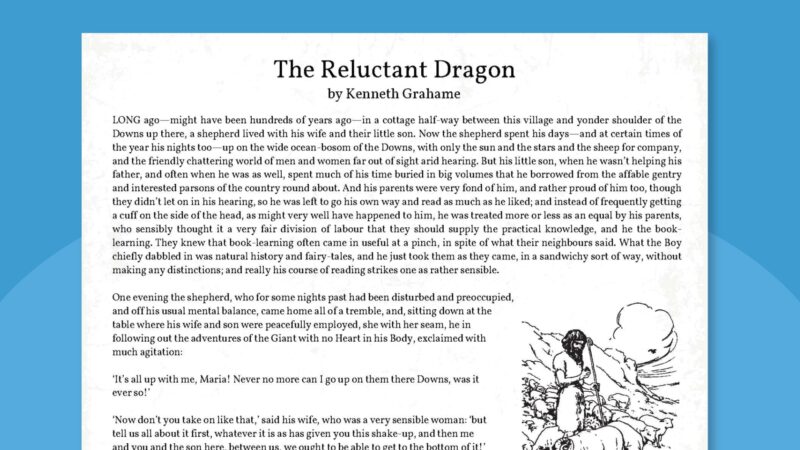
“LONG ago—might have been hundreds of years ago—in a cottage half-way between this village and yonder shoulder of the Downs up there, a shepherd lived with his wife and their little son.”
Why we love it: This story is a good way to introduce young kids to the concepts of bullying and prejudice. Through the story, kids will learn that they shouldn’t judge things by appearances as the dragon in the story is not what he seems.
“The Fisherman and His Wife” by The Brothers Grimm
“Once upon a time there were a fisherman and his wife who lived together in a filthy shack near the sea. Every day the fisherman went out fishing, and he fished, and he fished. Once he was sitting there fishing and looking into the clear water, and he sat, and he sat. Then his hook went to the bottom, deep down, and when he pulled it out, he had caught a large flounder.”
Why we love it: Teaching young people the value of appreciating what you have and not always seeking out more is of the utmost importance. This short story encapsulates that and warns about the pitfalls of greed.
“The Great Stone Face” by Nathaniel Hawthorne
“One afternoon, when the sun was going down, a mother and her little boy sat at the door of their cottage, talking about the Great Stone Face. They had but to lift their eyes, and there it was plainly to be seen, though miles away, with the sunshine brightening all its features.”
Why we love it: This story weaves nature and divinity in a story that centers around a great stone face that encapsulates qualities like wisdom and nobility.
Get your free printable Short Stories for Kids:

Just share your email address for instant access to full-text printable versions of all the short stories for kids on this list.
